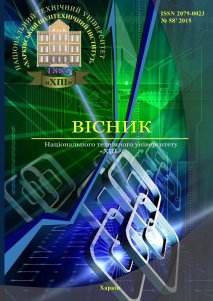METHODS AND TOOLS FOR DYNAMIC REQUIREMENTS CATALOG MANAGEMENT IN AGILE SOFTWARE DEVELOPMENT
DOI:
https://doi.org/10.20998/%25xAbstract
A method for managing dynamic requirements catalog in agile software development, especially on example of Scrum-methodology is proposed. Popular approaches to solving this problem are reviewed. The proposed approach is based on the combined usage of the latent semantic analysis and analytical hierarchy process, it allows to evaluate the given textual software specification with respect to their possible redundancy and possible logical conflicts. Besides that this approach supports the decision making procedure to prioritize the requirements taking into account their functionality importance for target software product. The effectiveness of the proposed method was tested on the test case.
References
Anderson D. J. Agile Management for Software Engineering / D.J. Anderson // Prentice Hall, 2003. – 336 p.
Ambler S. Agile Architecture: Strategies for Scaling Agile Software Development / S. Ambler // Web http://agilemodeling.com/essays/agileArchitecture.htm
Ambler S. Agile/Evolutionary Data Modeling: From Domain Modeling to Physical Modeling / S. Ambler // Web http://agiledata.org/essays/agileDataModeling.html#DisasterStrikes
Evans E. Domain-Driven Design: Tackling Complexity in the Heart of Software / E. Evans. – Addison-Wesley. – 2003. – 359 p. //
Hong Xu. Requirement process establishment and improvement from the viewpoint of cybernetics / Hong Xu, Pete Sawyer, Ian Sommerville. // The Journal of Systems and Software, issue. – 2006. – № 79. – P. 1504–1513.
Tkachuk M. V. Models and Tools for Effectiveness Increasing of Requirements Traceability in Agile Software Development / M. V. Tkachuk, R. O. Gamzayev, H. C. Mayr, V. O. Bolshutkin // Проблемы программирования. – К.: НАН України. – 2012. – № 2–3 (спец. выпуск). – С. 252–260.
Селяков Е. Б. Методика выбора требований при проектировании АСУТП на основе логико-формальной модели системы требований / Е. Б. Селяков // Вісник Донецького національного університету, Сер. А: Природничі науки. – 2009. – вип. 1. – С. 472–477.
Kop C. An Interlingua based Approach to Derive State Charts form Natural Language Requirements In: Hamza M.H. (Hrsg.) / C. Kop, H. C. Mayr // Proceedings of the 7th IASTED Anaheim, Calgary, Zurich: Acta Press, – 2003. – P. 538 – 543.
Ilieva M., Representing Textual Requirements as Graphical Natural Language for UML-diagram Generation / M. Ilieva, H. Boley // Proceedings of the Twentieth International Conference on Software Engineering & Knowledge Engineering, San Francisco, CA. – 2008. – P. 478 – 483
Highsmith J. Agile Project Management. / Highsmith J. – Addison-Wesley – 2004. – 277 p.
Фаулер М. Архитектура корпоративных программных приложений / Фаулер М.; пер. с англ. – М.:Вильямс, 2006. –404 с.
Olson L. Advanced Data Mining Techniques/ Olson L., Delen D.– Berlin: Springer-Verlag. . – 2008. – 180 p.
Ланде Д. В. Основы интеграции информационных потоков. / Ланде Д. В. – К. Инжиниринг, 2006. – 240 с.
Антонова А. А. Применение латентно-семантического анализа при кластеризации слов на основании их контекстов / А. А. Антонова, Е. А. Ильюшина, А. В. Прохоров // Тезисы докладов научной конференции «Ломоносовские чтения». – М.: Изд-во МГУ, 2007. – C. 23–24.
Racheva Z. Supporting the Dynamic Reprioritization of Requirements in Agile Development of Software Products / Z. Racheva, M. Daneva, L. Buglione, // 2nd International Workshop on Software Product Management, – 2008. – P. 49–58.
Саати Т. Принятие решений – метод анализа иерархий / Саати Т. – М.: Радио и связь, 1993. – 278 с.
Вентцель Е. С. Теория вероятностей и ее инженерные приложения. / Вентцель Е. С., Овчарова Л. А. – М: Наука, 1988. – 480 с.
Matlab – Web http://www.mathworks.com
Open Office . – Web http://wiki.openoffice.org/wiki/Documentation/OOoAuthors_User_Manual/Migration_Guide/Calc_and_Excel
Downloads
Published
How to Cite
Issue
Section
License
Copyright (c) 2016 Вісник Національного технічного університету «ХПІ». Серія: Системний аналiз, управління та iнформацiйнi технологiїAuthors who publish with this journal agree to the following terms:
- Authors retain copyright and grant the journal right of first publication with the work simultaneously licensed under a Creative Commons Attribution License that allows others to share the work with an acknowledgement of the work's authorship and initial publication in this journal.
- Authors are able to enter into separate, additional contractual arrangements for the non-exclusive distribution of the journal's published version of the work (e.g., post it to an institutional repository or publish it in a book), with an acknowledgement of its initial publication in this journal.
- Authors are permitted and encouraged to post their work online (e.g., in institutional repositories or on their website) prior to and during the submission process, as it can lead to productive exchanges, as well as earlier and greater citation of published work (See The Effect of Open Access).


